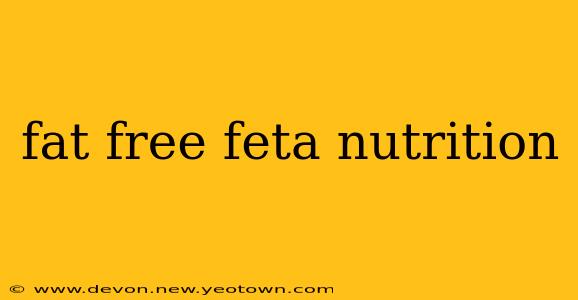Feta cheese, with its tangy, salty flavor, is a staple in Mediterranean cuisine. But what about the "fat-free" versions? Are they a healthy swap for their full-fat counterparts, or are there nutritional trade-offs? Let's unravel the nutritional profile of fat-free feta and explore the questions many people have.
What is the nutritional information of fat-free feta cheese?
The nutritional content of fat-free feta can vary slightly depending on the brand. However, generally speaking, a standard serving (approximately 28 grams or one ounce) will offer a relatively low calorie count, significantly reduced fat compared to traditional feta, and a decent amount of protein. You'll also find some calcium and sodium. It's important to check the specific nutritional label of your chosen brand, as these values can fluctuate. The reduced fat content is achieved through processing techniques, often involving the removal of fat or the use of milk with a lower fat content. This process naturally alters the texture and flavor profile compared to the full-fat version, which many find to be less creamy and slightly less flavorful.
How does fat-free feta compare to regular feta?
The primary difference lies in the fat content. Regular feta boasts a rich, creamy texture thanks to its higher fat content, typically around 20-25% fat. This fat contributes to the flavor and texture. Fat-free feta, as its name implies, drastically reduces this percentage, usually to less than 1%. This reduction results in a lower calorie count per serving. However, it also means a reduction in fat-soluble vitamins like Vitamins A, D, E, and K which are naturally found in the fat of the cheese. The protein content is relatively similar between the two, making fat-free feta a potentially viable protein source. But be aware that the altered texture and flavor might not appeal to everyone who enjoys the traditional full-fat feta.
Is fat-free feta a healthy choice?
Whether fat-free feta is a "healthy" choice depends heavily on individual dietary needs and preferences. It can be part of a balanced diet for those watching their fat intake. Its lower calorie and fat content can be beneficial for weight management. However, the reduction in fat also impacts the flavor and texture, and some find the texture less appealing. It also may lack some of the nutritional benefits associated with full-fat feta. The sodium content is a factor to consider; many individuals need to monitor their sodium levels. Always check the nutritional label for sodium content and incorporate it into your daily allowance.
What are some alternatives to fat-free feta?
If you're seeking a healthier alternative to full-fat feta while maintaining some of its creamy texture and rich flavor, consider exploring part-skim feta or exploring other cheeses with lower fat content but still some of the satisfying qualities of feta. You could also look into using alternatives like crumbled goat cheese, which sometimes offers a similar tangy flavor but a different texture.
What are the potential downsides of consuming fat-free feta?
While the lower fat content is appealing to many, it's crucial to understand that the process of removing fat can impact both taste and texture. Some individuals might find the taste less satisfying or the texture less creamy. Furthermore, the removal of fat might also remove some fat-soluble vitamins, altering the overall nutritional profile slightly. The increased sodium content in some brands can also be a concern for those watching their sodium intake.
In conclusion, fat-free feta cheese offers a lower-calorie, lower-fat alternative to traditional feta. However, it's essential to weigh the potential benefits against any drawbacks concerning taste, texture, and altered nutritional profile. The best choice ultimately depends on your individual dietary goals and preferences. Always read nutritional labels carefully to make informed decisions about the food you consume.

